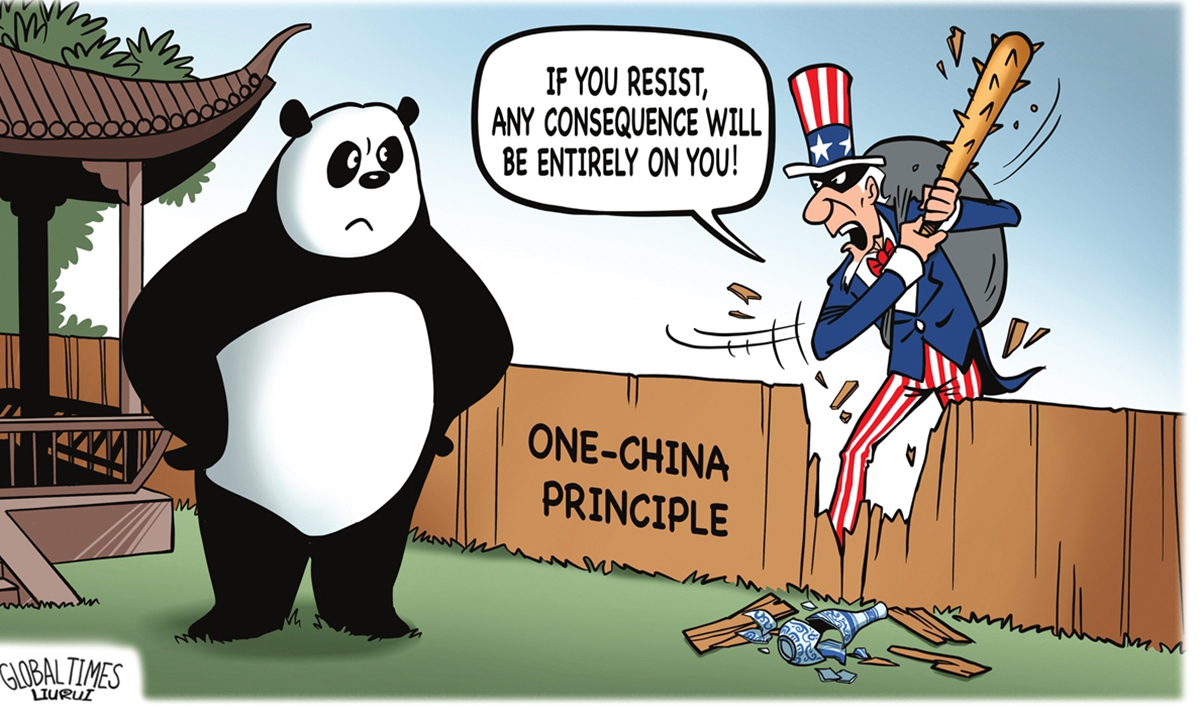China should do the same as the US - say yes, then dump some treasuries and accelerate ditching of the dollar.and if he offers to veto, he'd probably ask xi jinping to help the us tackle their inflation/economic situation
You are using an out of date browser. It may not display this or other websites correctly.
You should upgrade or use an alternative browser.
You should upgrade or use an alternative browser.
Fourth Taiwan Strait Crisis
- Thread starter sndef888
- Start date
- Status
- Not open for further replies.
Status quo changed, a summary...
Here are the 10 breakthroughs in China's 2022 Taiwan military drill
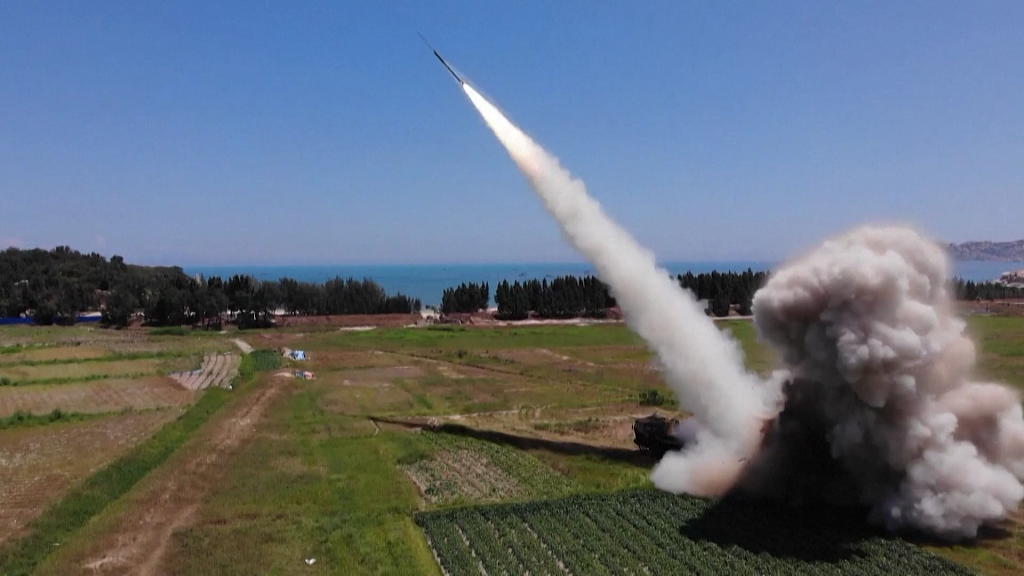
A missile is launched during a military drill, China, August 4, 2022. /CFP
The visit by U.S. House Speaker Nancy Pelosi to Taiwan has turned many Chinese people into military fans, as China took unprecedented military actions to protect its territorial integrity.
The military drill in early August made 10 breakthroughs in the history of the People's Liberation Army (PLA), according to "Yuyuan Tantian," a Chinese social media outlet affiliated with China Media Group.
1. PLA Navy approached Taiwan coastline
Ten Chinese warships conducted a real combat-oriented drill near the country's Taiwan island on August 5.
Photos of the drill taken by the PLA Eastern Theater Command showed that the coastline and mountains on the island are clearly visible on a warship.
This action has meant that Taiwan is a part of China, and it's normal for a PLA Navy fleet to sail in China's own territorial sea.
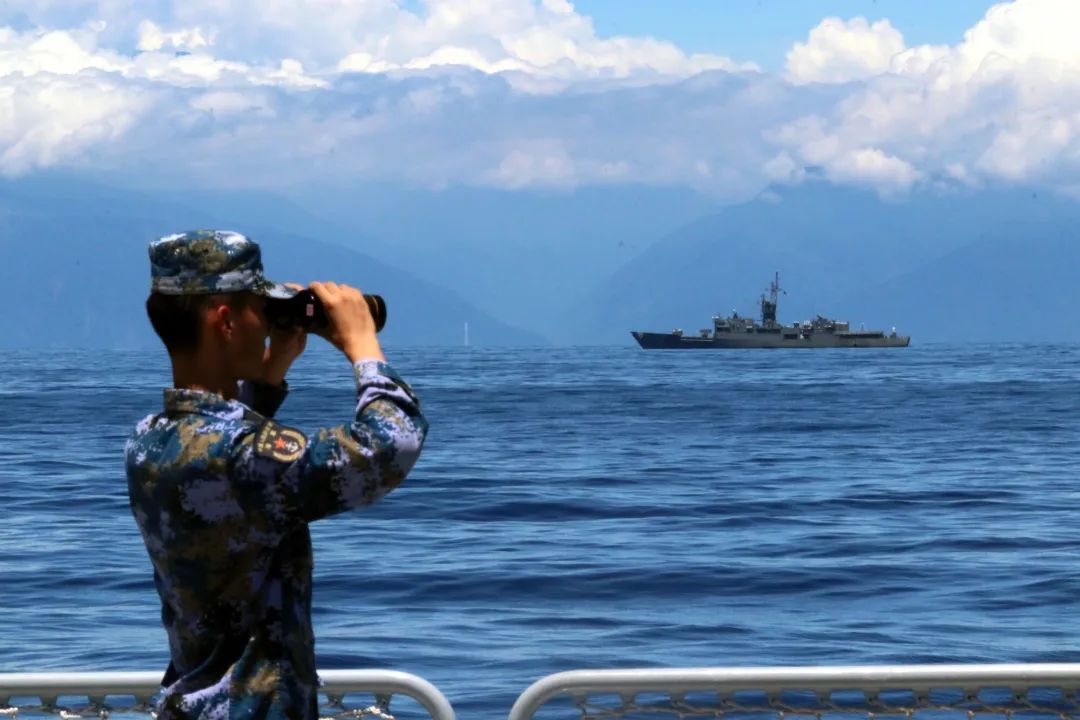
A PLA Navy soldier watches Taiwan island with a binocle during a military drill, August 5, 2022. /CMG
2. PLA Air Force saw Taiwan coastline with naked eyes
The PLA also dispatched warplanes in the same drill. The pilots reported that they could see the coastline and mountains on the island with naked eyes.
This, like the warship drill, implied that the so-called "Taiwan's territorial air space" by the separatists makes no real sense.
3. PLA missiles flew over Taiwan
The PLA launched multiple types of missiles toward Taiwan island, which for the first time flew across the island and hit the targets in the sea.
"Speaking in this way may be easier for the separatists to understand," said Yuyuan Tantian.
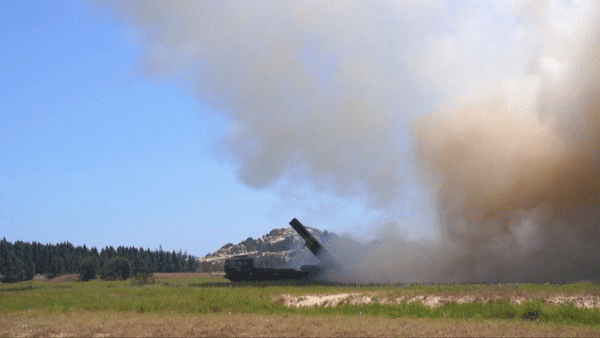
A missile is launched during a military drill, China, August 4, 2022. /CFP
4. J-20 participated in Taiwan military drill
China's latest type of fight jet, the J-20, debuted in a Taiwan-related military drill.
Yuyuan Tantian said the jet broke the U.S. monopoly in stealth fight jet, filling up the generation gap between the PLA Air Force and the world's best air forces.
"This drill was a small test for the J-20 but it put a major psychological pressure on the Taiwan separatists," added Yuyuan Tantian.
5. No 'median line' of Taiwan Straits
The so-called "median line" in the Taiwan Straits exists only in the imagination of separatists, said Yuyuan Taitian.
Before the drill began, China issued a warning to ships and aircraft that six areas around Taiwan would be targeted, among which five are on the eastern side of the so-called“median line," with the sixth one laid across it.
"The drill has meant that China has full control of the Taiwan Straits," said Yuyuan Tantian. "Military training on the eastern side of the line will become a normal in the near future."
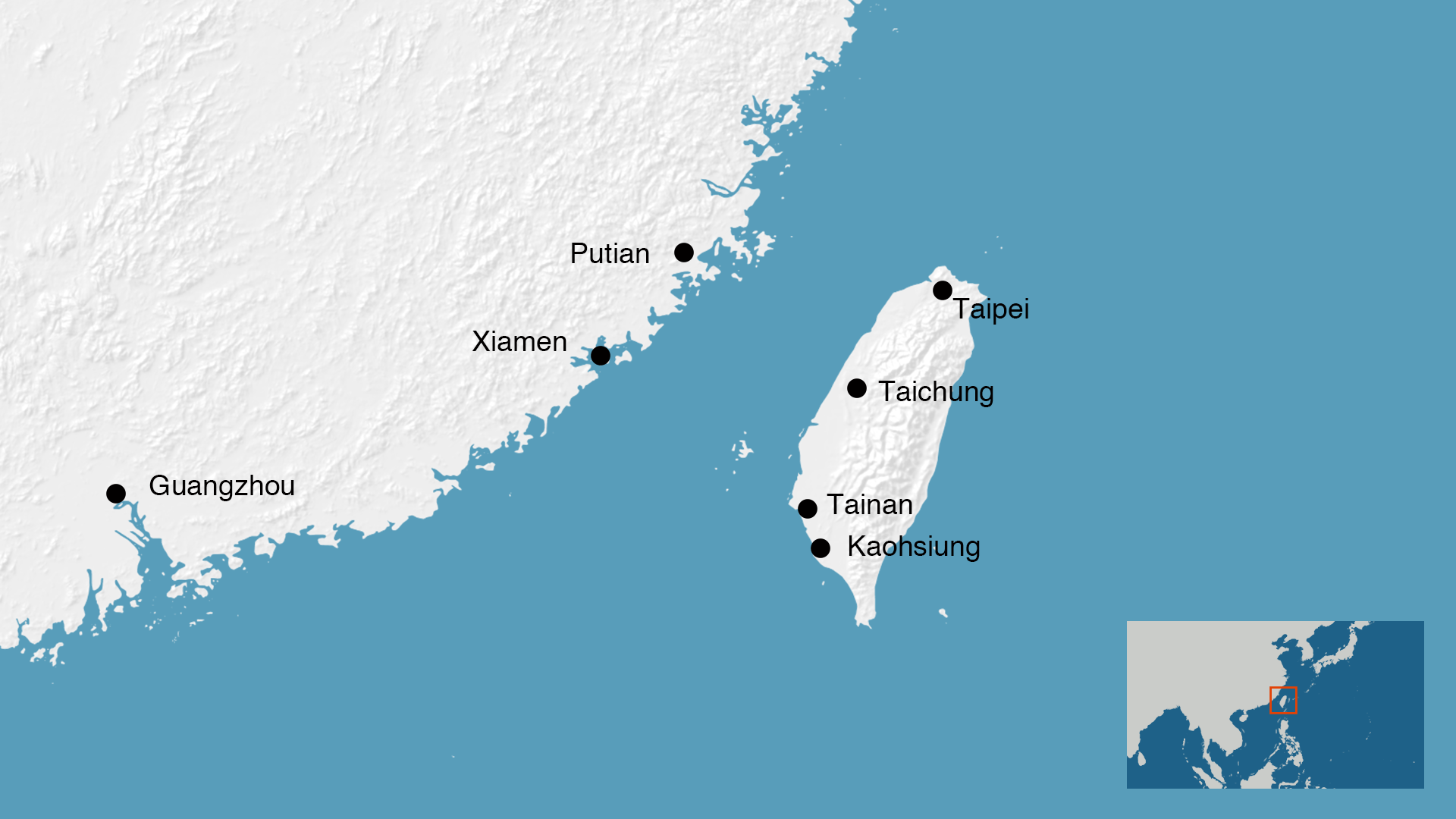
A map showing the areas of the military drill. /CGTN
6. The closest drill to the island
One of the six targets of the drill is only 20 kilometers away from the Taiwan island, marking the drill the closest of its kind to Taiwan.
A J-20 can fly 20 km in less than half a minute.
7. No outside interference
The PLA tried to repel foreign interference during the drill on August 4, according to the Eastern Theater Command.
One of the drill areas was set to the northeast of Taiwan, close to Okinawa controlled by Japan.
If the U.S. and Japan want to interfere with China's unifying process, they will dispatch warplanes from the military base in Okinawa, Yuyuan Tantian said, quoting an unnamed military source.
And another area was in the Bashi Channel, blocking the access to Taiwan from the South China Sea.
8. No escape paths
A drill area was set to the east of the island for the first time, locking the escape paths of the Taiwan separatists.
With this new area blocked, the island was surrounded by the PLA, leaving no way to run.
9. First deterrence drill with aircraft carrier
The PLA also dispatched aircraft carrier formations to carry out the deterrence missions, which was the first time in the army's history.
Nuclear submarines usually move with the carriers during such missions, said Zhang Junshe, a researcher at the PLA Naval Research Academy.
10. An all-out drill by PLA forces
For the first time in 2022, the PLA went all out with all five types of forces: Army, Navy, Air Force, Rocket Force and Strategic Support Force.
The army also sent out all weapon types including aircraft carriers, fighter jets, long-range rocket systems and missiles.
Additionally, they also carried out all kinds of missions like joint blockade, deterrence, and actions against ground, sea, air targets.
"All of this made it clear," said Yuyuan Tantian, "that China's reunification must and will be achieved."
Here are the 10 breakthroughs in China's 2022 Taiwan military drill

A missile is launched during a military drill, China, August 4, 2022. /CFP
The visit by U.S. House Speaker Nancy Pelosi to Taiwan has turned many Chinese people into military fans, as China took unprecedented military actions to protect its territorial integrity.
The military drill in early August made 10 breakthroughs in the history of the People's Liberation Army (PLA), according to "Yuyuan Tantian," a Chinese social media outlet affiliated with China Media Group.
1. PLA Navy approached Taiwan coastline
Ten Chinese warships conducted a real combat-oriented drill near the country's Taiwan island on August 5.
Photos of the drill taken by the PLA Eastern Theater Command showed that the coastline and mountains on the island are clearly visible on a warship.
This action has meant that Taiwan is a part of China, and it's normal for a PLA Navy fleet to sail in China's own territorial sea.

A PLA Navy soldier watches Taiwan island with a binocle during a military drill, August 5, 2022. /CMG
2. PLA Air Force saw Taiwan coastline with naked eyes
The PLA also dispatched warplanes in the same drill. The pilots reported that they could see the coastline and mountains on the island with naked eyes.
This, like the warship drill, implied that the so-called "Taiwan's territorial air space" by the separatists makes no real sense.
3. PLA missiles flew over Taiwan
The PLA launched multiple types of missiles toward Taiwan island, which for the first time flew across the island and hit the targets in the sea.
"Speaking in this way may be easier for the separatists to understand," said Yuyuan Tantian.

A missile is launched during a military drill, China, August 4, 2022. /CFP
4. J-20 participated in Taiwan military drill
China's latest type of fight jet, the J-20, debuted in a Taiwan-related military drill.
Yuyuan Tantian said the jet broke the U.S. monopoly in stealth fight jet, filling up the generation gap between the PLA Air Force and the world's best air forces.
"This drill was a small test for the J-20 but it put a major psychological pressure on the Taiwan separatists," added Yuyuan Tantian.
5. No 'median line' of Taiwan Straits
The so-called "median line" in the Taiwan Straits exists only in the imagination of separatists, said Yuyuan Taitian.
Before the drill began, China issued a warning to ships and aircraft that six areas around Taiwan would be targeted, among which five are on the eastern side of the so-called“median line," with the sixth one laid across it.
"The drill has meant that China has full control of the Taiwan Straits," said Yuyuan Tantian. "Military training on the eastern side of the line will become a normal in the near future."

A map showing the areas of the military drill. /CGTN
6. The closest drill to the island
One of the six targets of the drill is only 20 kilometers away from the Taiwan island, marking the drill the closest of its kind to Taiwan.
A J-20 can fly 20 km in less than half a minute.
7. No outside interference
The PLA tried to repel foreign interference during the drill on August 4, according to the Eastern Theater Command.
One of the drill areas was set to the northeast of Taiwan, close to Okinawa controlled by Japan.
If the U.S. and Japan want to interfere with China's unifying process, they will dispatch warplanes from the military base in Okinawa, Yuyuan Tantian said, quoting an unnamed military source.
And another area was in the Bashi Channel, blocking the access to Taiwan from the South China Sea.
8. No escape paths
A drill area was set to the east of the island for the first time, locking the escape paths of the Taiwan separatists.
With this new area blocked, the island was surrounded by the PLA, leaving no way to run.
9. First deterrence drill with aircraft carrier
The PLA also dispatched aircraft carrier formations to carry out the deterrence missions, which was the first time in the army's history.
Nuclear submarines usually move with the carriers during such missions, said Zhang Junshe, a researcher at the PLA Naval Research Academy.
10. An all-out drill by PLA forces
For the first time in 2022, the PLA went all out with all five types of forces: Army, Navy, Air Force, Rocket Force and Strategic Support Force.
The army also sent out all weapon types including aircraft carriers, fighter jets, long-range rocket systems and missiles.
Additionally, they also carried out all kinds of missions like joint blockade, deterrence, and actions against ground, sea, air targets.
"All of this made it clear," said Yuyuan Tantian, "that China's reunification must and will be achieved."
Related?Taiwan finally decided to fight-back? Let's wait and see what they have to say at 3PM (local Taiwan time).
In response to PLA’s decision to conduct continuous military exercise around Taiwan:
Last edited:
Maybe not. Taiwan's Press Conference concluded, not updating anything because they basically said nothing. Usual stuff from Taiwan Generals with "prepare for war but not seeking one, will not fire first shot, closely monitoring further, confidential stuff no comment etc etc".
Basically not doing anything new they haven't done, lol.
APT1450, I wonder how good they are in a CTF against the APT27
I believe these exercises are just intended as a warning, with a liberation of Taiwan operation as a backup. But what might be the real timeline, if Xi has decided to end the civil war after the exercises?AUGUST 2022.... its happening
The Taiwan policy act is almost certain to pass, probably with some symbolic amendments which won't be enough to satisfy China that the one China policy hasn't been terminated. Considering the legislative process in the US is slow, this will take some time. They'll probably try to get it done before the midterm elections, so maybe in October. There'll probably be more exercises in response.
The midterm elections are at the start of November and will give an indication of where American policy is headed.
In November temperatures are going to drop in Europe and Ukrainians are going to freeze and the EU will try to save as much energy as possible. They won't be able to join a trade war.
The Taiwan local elections are at the end of November and we'll see if the people on Taiwan choose to support the DPP despite the exercises or if they become more mainland friendly and support the KMT.
During the Christmas/New Year holidays, the west doesn't pay attention to international events.
The weather conditions across the Taiwan strait are ideal in April to July, but this also makes a US response easier. So it might be best to liberate the island when it's hardest for the US to respond, so in the middle of winter.
Given this timetable, I'd say the best time for reunification is in December. The Taiwanese residents will see a demonstration in Ukraine of how bad conditions can become if they choose to fight and many will choose that they'd rather be communist than live in poverty. They'll see the US fail to respond adequately to the PLA and their belief in the US security guarantee will reduce. They know that if the US doesn't rescue them, they can't win. They get one chance to express their feelings in the local elections at the end of November. If they overwhelmingly choose the DPP, then the central government knows that its hopes for a peaceful reunification are futile. So in response to the local elections, another exercise can begin that turns into a blockade and then start the attack after two or three weeks when fuel is running low on Taiwan. Of course it would be more exciting if it happened now, but that's not the smartest strategy
China need time to dispose western assets.I believe these exercises are just intended as a warning, with a liberation of Taiwan operation as a backup. But what might be the real timeline, if Xi has decided to end the civil war after the exercises?
The Taiwan policy act is almost certain to pass, probably with some symbolic amendments which won't be enough to satisfy China that the one China policy hasn't been terminated. Considering the legislative process in the US is slow, this will take some time. They'll probably try to get it done before the midterm elections, so maybe in October. There'll probably be more exercises in response.
The midterm elections are at the start of November and will give an indication of where American policy is headed.
In November temperatures are going to drop in Europe and Ukrainians are going to freeze and the EU will try to save as much energy as possible. They won't be able to join a trade war.
The Taiwan local elections are at the end of November and we'll see if the people on Taiwan choose to support the DPP despite the exercises or if they become more mainland friendly and support the KMT.
During the Christmas/New Year holidays, the west doesn't pay attention to international events.
The weather conditions across the Taiwan strait are ideal in April to July, but this also makes a US response easier. So it might be best to liberate the island when it's hardest for the US to respond, so in the middle of winter.
Given this timetable, I'd say the best time for reunification is in December. The Taiwanese residents will see a demonstration in Ukraine of how bad conditions can become if they choose to fight and many will choose that they'd rather be communist than live in poverty. They'll see the US fail to respond adequately to the PLA and their belief in the US security guarantee will reduce. They know that if the US doesn't rescue them, they can't win. They get one chance to express their feelings in the local elections at the end of November. If they overwhelmingly choose the DPP, then the central government knows that its hopes for a peaceful reunification are futile. So in response to the local elections, another exercise can begin that turns into a blockade and then start the attack after two or three weeks when fuel is running low on Taiwan. Of course it would be more exciting if it happened now, but that's not the smartest strategy
Rather than warning, it's that more and more equipment is sent to Fujian and I don't see the stuff going home until the civil war is over. On day 1 of the crisis, people even spotted APCs with active defense systems which haven't ever been seen during open events. These are almost certainly 100% war ready units.I believe these exercises are just intended as a warning, with a liberation of Taiwan operation as a backup. But what might be the real timeline, if Xi has decided to end the civil war after the exercises?
The Taiwan policy act is almost certain to pass, probably with some symbolic amendments which won't be enough to satisfy China that the one China policy hasn't been terminated. Considering the legislative process in the US is slow, this will take some time. They'll probably try to get it done before the midterm elections, so maybe in October. There'll probably be more exercises in response.
The midterm elections are at the start of November and will give an indication of where American policy is headed.
In November temperatures are going to drop in Europe and Ukrainians are going to freeze and the EU will try to save as much energy as possible. They won't be able to join a trade war.
The Taiwan local elections are at the end of November and we'll see if the people on Taiwan choose to support the DPP despite the exercises or if they become more mainland friendly and support the KMT.
During the Christmas/New Year holidays, the west doesn't pay attention to international events.
The weather conditions across the Taiwan strait are ideal in April to July, but this also makes a US response easier. So it might be best to liberate the island when it's hardest for the US to respond, so in the middle of winter.
Given this timetable, I'd say the best time for reunification is in December. The Taiwanese residents will see a demonstration in Ukraine of how bad conditions can become if they choose to fight and many will choose that they'd rather be communist than live in poverty. They'll see the US fail to respond adequately to the PLA and their belief in the US security guarantee will reduce. They know that if the US doesn't rescue them, they can't win. They get one chance to express their feelings in the local elections at the end of November. If they overwhelmingly choose the DPP, then the central government knows that its hopes for a peaceful reunification are futile. So in response to the local elections, another exercise can begin that turns into a blockade and then start the attack after two or three weeks when fuel is running low on Taiwan. Of course it would be more exciting if it happened now, but that's not the smartest strategy
Also the emphasis on China's low spending could very well be shown to a misdirection much like how Russians had way more missiles than the West believed they had stockpiled.
If China is gonna bide their time, the govt would have gone out to announce higher budget and military buildup in response to US aggression. However if they're gonna hit sooner rather than later, then a secret mobilization and rearmament makes more sense. There may have been several years where China already had real spending on par with NATO level.
Winter attack makes more sense because the heightened difficulty will disfavor US who suffers more from tyranny of distance.
US invasion seems more and more inevitable, but as with almost every major cold war battlefield between China and America, China came out ahead due to better and longer term planning, it wouldn't be out of line to assume this battlefield will be the same.
China is no Ukraine nor Poland, they'll not sit around as US plans to take territory and start a world war. Beijing will move first and by the time US is ready to flood Taiwan with little green men and declare Taiwan "independence", the guns and missiles of the PLA will already be waiting on the Eastern shoreline.
- Status
- Not open for further replies.

